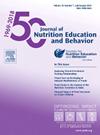关于阿肯色州食品:当地种植的营养教育
IF 2.3
3区 医学
Q2 EDUCATION, SCIENTIFIC DISCIPLINES
引用次数: 0
摘要
实施一项以当地种植的食物为重点的营养教育计划。理论或研究的使用研究表明,营养教育干预有可能改善儿童的饮食质量,并与更积极的食物选择有关。目标受众:两所符合SNAP-Ed标准的小学的幼儿园到五年级学生。项目描述阿肯色大学农业合作推广服务部(UADA CES) SNAP-Ed项目与阿肯色阿什利县的两所学校合作,实施一项以阿肯色种植食品为重点的营养教育项目。在整个2023-24学年,代理商利用阿肯色州食品公司的课程与219名年轻人建立了联系。课程涵盖了每种食物是如何种植的,食物的营养价值,以及如何食用这些食物。学生们学习并品尝了蔬菜、冬南瓜、鸡肉、坚果、硬奶酪和软奶酪、燕麦和草莓。大多数学生在课堂上品尝了提供的食物。在面对面的青少年教育之后,家长们收到了关于当地种植食物的教育信息的通讯。评估方法采用二维码调查方式对学生进行调查。在青少年面对面教育结束后,父母们在发送回家的通讯中使用二维码进行了调查。在项目结束时,通过电子邮件链接对教师进行了调查。结果在接受调查的学生中,94%的人表示他们喜欢在课堂上品尝食物。在完成了邮件二维码调查的父母中,31%的人表示他们在家准备了邮件中的食谱,88%的人表示他们喜欢其中的特色食物。教师调查结果显示,100%的教师认为该计划很有价值,86%的教师说学生提到改变他们在家的饮食方式,100%的教师因为该计划而吃得更健康。学生们对当地种植的食物表现出更大的接受度,并对这些食物的种植方式有了更深入的了解。家长们报告说,他们在家与家人一起使用课程中的食谱,老师们观察到学生们讨论积极的饮食变化,并养成更健康的饮食习惯。FundingSNAP-Ed本文章由计算机程序翻译,如有差异,请以英文原文为准。
All About Arkansas Foods: Locally Grown Nutrition Education
Objective
Implement a nutrition education program focusing on locally grown foods.
Use of Theory or Research
Studies show nutrition education interventions have potential to improve children’s diet quality and are associated with more positive food choices.
Target Audience
Kindergarten through 5th grade students in two SNAP-Ed eligible elementary schools.
Program Description
The University of Arkansas Division of Agriculture Cooperative Extension Service (UADA CES) SNAP-Ed Program partnered with two schools in Ashley County, Arkansas to implement a nutrition education program focusing on Arkansas-grown foods. Throughout the 2023-24 school year, the Agent utilized the Arkansas Foods curriculum to connect with 219 youth. Lessons covered how each food is grown, the nutrition benefits of the food, and how the food may be consumed. Students learned about and sampled greens, winter squash, chicken, nuts, hard and soft cheese, oats, and strawberries. A majority of students tasted the food offerings during the lessons. Parents received newsletters with educational information about the locally grown foods following the in-person youth education.
Evaluation Methods
Student were surveyed using a QR code survey. Parents were surveyed utilizing a QR code on newsletters sent home following youth in-person education. Teachers were surveyed at the conclusion of the program using an email link to an electronic survey.
Results
Among student respondents, 94% indicated they liked the food tasting they received as part of the lesson. Of the parents who completed the newsletter QR code survey, 31% indicated they prepared the recipe included in the newsletter at home and 88% indicated they liked the featured food. Teacher survey results showed that 100% of teachers found the program valuable, 86% of teachers said students mentioned changing how they eat at home, and 100% of teachers were motivated to eat healthier as a result of the program.
Conclusions
Students demonstrated greater acceptance of locally grown foods and gained a deeper understanding of how these foods are grown. Parents reported using recipes from the curriculum at home with their families, and teachers observed students discussing positive dietary changes and embracing healthier eating habits themselves.
Funding
SNAP-Ed
求助全文
通过发布文献求助,成功后即可免费获取论文全文。
去求助
来源期刊
CiteScore
4.20
自引率
11.50%
发文量
379
审稿时长
44 days
期刊介绍:
The Journal of Nutrition Education and Behavior (JNEB), the official journal of the Society for Nutrition Education and Behavior, is a refereed, scientific periodical that serves as a global resource for all professionals with an interest in nutrition education; nutrition and physical activity behavior theories and intervention outcomes; complementary and alternative medicine related to nutrition behaviors; food environment; food, nutrition, and physical activity communication strategies including technology; nutrition-related economics; food safety education; and scholarship of learning related to these areas.
The purpose of JNEB is to document and disseminate original research and emerging issues and practices relevant to these areas worldwide. The Journal of Nutrition Education and Behavior welcomes evidence-based manuscripts that provide new insights and useful findings related to nutrition education research, practice and policy. The content areas of JNEB reflect the diverse interests in nutrition and physical activity related to public health, nutritional sciences, education, behavioral economics, family and consumer sciences, and eHealth, including the interests of community-based nutrition-practitioners. As the Society''s official journal, JNEB also includes policy statements, issue perspectives, position papers, and member communications.

 求助内容:
求助内容: 应助结果提醒方式:
应助结果提醒方式:


